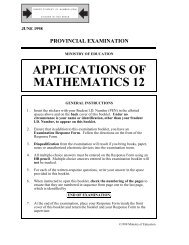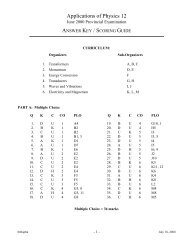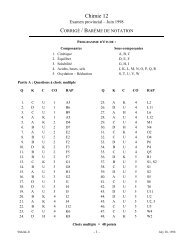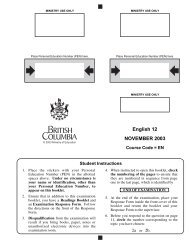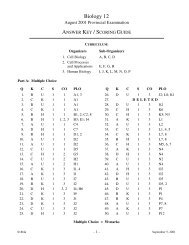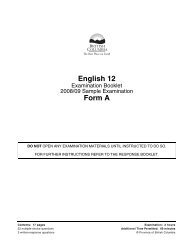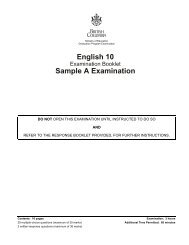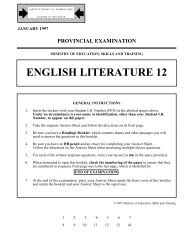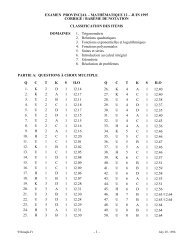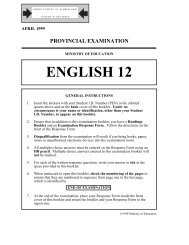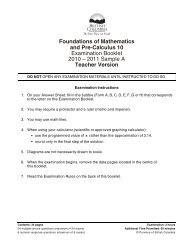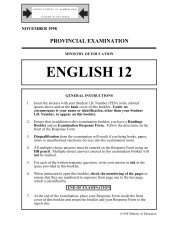CHEMISTRY 12
CHEMISTRY 12
CHEMISTRY 12
You also want an ePaper? Increase the reach of your titles
YUMPU automatically turns print PDFs into web optimized ePapers that Google loves.
THIS PAGE INTENTIONALLY BLANK
<strong>CHEMISTRY</strong> <strong>12</strong> PROVINCIAL EXAMINATION1. This examination consists of two parts:ValueSuggestedTimePART A: 48 multiple-choice questions 48 70PART B: 11 written-response questions 32 50Total: 80 marks <strong>12</strong>0 minutes2. Aside from an approved calculator, electronic devices, including dictionaries and pagers, arenot permitted in the examination room.3. The following tables can be found in the separate Data Booklet.• Periodic Table of the Elements• Atomic Masses of the Elements• Names, Formulae, and Charges of Some Common Ions• Solubility of Common Compounds in Water• Solubility Product Constants at 25° C• Relative Strengths of Brönsted-Lowry Acids and Bases• Acid-Base Indicators• Standard Reduction Potentials of Half-cellsNo other reference materials or tables are allowed.4. A calculator is essential for the Chemistry <strong>12</strong> Provincial Examination. The calculator mustbe a hand-held device designed primarily for mathematical computations involving logarithmicand trigonometric functions. Computers, calculators with a QWERTY keyboard, and electronicwriting pads will not be allowed. Students must not bring any external devices to supportcalculators such as manuals, printed or electronic cards, printers, memory expansion chips orcards, or external keyboards. Students may have more than one calculator available during theexamination. Calculators may not be shared, and communication between calculators isprohibited during the examination. In addition to an approved calculator, students will beallowed to use rulers, compasses, and protractors during the examination.5. The time allotted for this examination is two hours.
PART A: MULTIPLE CHOICEValue: 48 marksINSTRUCTIONS:Suggested Time: 70 minutesFor each question, select the best answer and record your choice on the ResponseForm provided. Using an HB pencil, completely fill in the circle that has the lettercorresponding to your answer.1. Which of the following reactions occurs most rapidly at room temperature?A. H 2( g)+I 2( g)→ 2HI ( g)B. 2Fe () s +O 2g ( ) → 2 FeO () s2+C. Cu ( aq)2−+S ( aq)→ CuS () sD. C 6 H <strong>12</strong> O 6( aq)+6O 2( g)→ 6CO 2( g)+6H 2 O ( g)2. Consider the following reaction:CO + NO 2 → CO 2 + NO∆H =−234 kJThe activation energy of the forward reaction is 134 kJ. What is the activation energy for thereverse reaction?A. −134 kJB. −100 kJC. 234 kJD. 368 kJ3. Which of the following will decrease the number of effective collisions during a chemicalreaction?A. Adding a catalyst.B. Increasing the surface area.C. Decreasing the temperature.D. Increasing reactant concentrations.- 1 -OVER
4. Consider the following reaction:The rate of reaction is increased byA. adding a catalyst.B. removing some O 2 .C. decreasing the temperature.D. increasing the volume of the container.2N 2 O 5( g)+110 kJ → 4NO 2( g)+O 2( g)5. Which of the following apply to all equilibrium systems?IIIIIIForward and reverse rates are equalMacroscopic properties are constantMass of reactants equals mass of productsA. I and II onlyB. I and III onlyC. II and III onlyD. I, II and III6. Consider the following equilibrium:The forward reaction isN 2( g)+3H → 2( g)← 2NH 3( g)+92 kJA. exothermic and entropy is increasing.B. exothermic and entropy is decreasing.C. endothermic and entropy is increasing.D. endothermic and entropy is decreasing.- 2 -
7. Consider the following equilibrium:PCl → 5( g)← PCl 3( g)+Cl 2( g)The equilibrium concentration of PCl 5 will increase whenA. PCl 3 is added.B. Cl 2 is removed.C. a catalyst is added.D. the volume of the container is increased.8. Consider the following equilibrium:N 2 O → 4( g)← 2NO 2( g)If the volume of the container is decreased, theA. K eq decreases.[ ] increases.B. N 2 O 4C. equilibrium does not shift.D. equilibrium shifts to the right.9. Consider the following equilibrium:For this reaction,A. K eq = [ CO 2 ]B. K eq =C. K eq =1[ CO 2 ][ CaCO 3 ][ ] CaOCO 2[ ][ ] CaO[ ][ ]D. K eq = CO 2CaCO 3CaO () s +CO → 2( g)← CaCO 3()s- 3 -OVER
10. Which of the following reactions most favours products?REACTIONK eqIIIIIIIV2SO 2( g)+O → 2( g)← 2SO 3( g)2.6 ×1022NO ( g)+O → 2( g)← 2NO 2( g)6.4 ×10 52CO ( g)+O → 2( g)← 2CO 2( g)2.5×10 152H 2( g)+O → 2( g)← 2H 2 O ( g)1. 7 × 10 27A. IB. IIC. IIID. IV11. Consider the following:C () s +H 2 O → ( g)← CO ( g)+H 2( g)At equilibrium in a 1.0 L container, there are 1. 60 × 10 −2 mol C, 1. 50 × 10 −2 mol H 2 O,3. 00 ×10 −1 mol CO, and 1. 00 × 10 −1 mol H 2 . The value of K eq isA. 0.500B. 2.00C. 80.0D. <strong>12</strong>5<strong>12</strong>. Consider the following equilibrium:N 2 O → 4( g)← 2NO 2( g)K eq = 1. 0 × 10 −2At equilibrium, the [ NO 2 ]= 2.0 ×10 −2 mol L and the [ N 2 O 4 ] isA. 4.0 ×10 −6 mol LB. 4.0 ×10 −2 mol LC. 2. 0 mol LD. 25 mol L- 4 -
13. Which of the following dissolves in water to form an ionic solution?A. O 2B. SiO 2C. KMnO 4D. C <strong>12</strong> H 22 O 1114. A dilute solution of AgNO 3 is added dropwise to each of the following test tubes until aprecipitate forms in each tube.0.2 MNaCl0.2 MFeCl 30.2 MCuCl 20.2 MNH 4 ClWhich solution requires the lowest [ Ag +] to just begin precipitation?A. NaClB. FeCl 3C. CuCl 2D. NH 4 Cl15. Which of the following is most soluble?A. Na 2 SB. CaSO 4C. PbCO 3D. Zn( OH) 2- 5 -OVER
16. The solubility of PbI 2 will increase with the addition ofA. PbI 2B. heat.C. water.D. Pb( NO 3 ) 22−17. Which of the following saturated solutions has the lowest [ SO 4 ] at 25° C ?A. SrSO 4B. PbSO 4C. CaSO 4D. BaSO 418. The solubility of MgCO 3 isA. 4.6 ×10 −11 MB. 6.8 ×10 −6 MC. 1. 4 × 10 −5 MD. 2.6 ×10 −3 M19. When equal volumes of 0.20 M Pb( NO 3 ) 2 and 0.20 M KI are mixed together,A. a precipitate forms since Trial Ion Product > K spB. a precipitate forms since Trial Ion Product < K spC. no precipitate forms since Trial Ion Product > K spD. no precipitate forms since Trial Ion Product < K sp20. Bubbles form when Mg () s is added to HCl ( aq). The gas produced isA. O 2B. H 2C. Cl 2D. H 2 O- 6 -
21. A substance which produces hydrogen ions in solution is the definition ofA. an Arrhenius acid.B. an Arrhenius base.C. a Brönsted-Lowry acid.D. a Brönsted-Lowry base.22. The number of conjugate pairs in a Brönsted-Lowry acid-base equation isA. 1B. 2C. 3D. 423.2−Which of the following is a stronger base than HPO 4 ?A. H 2 OB.−NO 2C.2−CO 3D.−H 2 PO 424. Consider the following equilibria:HTe − + HSe −HTe − + Se 2−→ ← H 2 Te + Se 2−→ ← HSe − + Te 2−Reactants are favoured in both equilibria. The order of acids from strongest to weakest isA. HTe − , HSe − , H 2 TeB. HSe − , H 2 Te, HTe −C. H 2 Te, HTe − , HSe −D. H 2 Te, HSe − , HTe −- 7 -OVER
25. The equilibrium expression for the ion product constant of water isA. K w = [ H 3 O +][ ] OH−B. K w =C. K w =1H 3 O +[ ][ ] OH−[ H 2 O] 2H 3 O +[ ][ ] OH−[ ][ ] OH−D. K w = H 3 O+[ H 2 O] 226. Calculate the pH of 0.01 M NaOH.A. 1. 0 × 10 −<strong>12</strong>B. 1. 0 × 10 −2C. 2.0D. <strong>12</strong>. 027. Consider the following:TEMPERATUREK w25° C 1. 0 × 10 −1450° C 5.5 × 10 −14When water is heated,[ ][ ][ ][ ]A. H 3 O +B. H 3 O +C. H 3 O +D. H 3 O +[ ][ ]and OH−and OH−both increase.both decrease.increases and OH−decreases and OH−[ ] decreases.[ ] increases.- 8 -
28. The [ H 3 O +] of a solution with a pOH of 4.60 isA. 4.0 ×10 −10 MB. 2.5×10 −5 MC. 6.6 ×10 −1 MD. 9.7 ×10 −1 M29. The K b expression for aniline, C 6 H 5 NH 2 , is+A. K b = [ C 6 H 5 NH 3 ][ ] OH−B. K b = [ C 6 H 5 NH −][ H 3 ] O+[ ][ ] OH−C. K b = C 6 H 5 NH 3 +[ C 6 H 5 NH 2 ][ ][ H 3 ] O+D. K b = C 6 H 5 NH−C 6 H 5 NH 2[ ]30. A solution of 0.10 M HPO 42− isA. acidic because K a < K bB. acidic because K a > K bC. basic because K b < K aD. basic because K b > K a31. Consider the following equilibrium:HInd + H 2 O → ← H 3 O + + Ind −At the transition point for an acid-base indicator,[ ]A. K a = Ind −[ ]B. K a = HIndC. K a = H 3 O +D. K a = H 3 O +[ ][ ][ ] OH−- 9 -OVER
32. A solution is amber with neutral red and colourless with phenolphthalein.The approximate pH of the solution isA. 4B. 6C. 8D. 1033. When a 1.0 M acidic solution is titrated with a 1.0 M basic solution, the pH at theequivalence point is 8.5. The reactants could beA. HBr and KOHB. HNO 3 and NH 3C. HCl and NaOHD. HNO 2 and NaOH34. The net ionic equation for the reaction between KOH ( aq)and HBr ( aq)is+A. K ( aq)+B. H ( aq)−+Br−+OH( aq)( aq)→ KBr () s→ H 2 O ( l)C. KOH ( aq)+HBr ( aq)→ KBr ( aq)+H 2 O ( l)+D. K ( aq)−+OH( aq)++H ( aq)−+Br( aq)+→ K( aq)−+Br( aq)+H 2 O ( l)35. Consider the following equilibrium for a buffer solution:CH 3 COOH + H 2 O → ← CH 3 COO − + H 3 O +When a small amount of acid is added to this system, and equilibrium is reestablished,[ ]A. CH 3 COO −and pH have both increased.[ ] and pH have both decreased.B. CH 3 COOH[ ]C. CH 3 COO −has decreased and pH remains relatively constant.[ ] has decreased and pH remains relatively constant.D. CH 3 COOH- 10 -
36. Which of the following dissolves in water to form a basic solution?A. NOB. SO 3C. CO 2D. K 2 O37. Which of the following is an equation representing a redox reaction?A. 2NO 2( g)→ N 2 O 4( g)B. Mg () s +Cl 2( g)→ MgCl 2()s+C. Ag ( aq)−+Cl( aq)→ AgCl () s++D. NH 3( aq)+H ( aq)→ NH 4 ( aq)38. Consider the following:O 3 + H 2 O + SO 2 → SO 42− + O2 + 2H +In the redox reaction above, the chemical species oxidized isA. H +B. O 3C. SO 2D.2−SO 439. A product of the oxidation of NO 2 isA. NOB. N 2 OC.−NO 2D.−NO 3- 11 -OVER
40. Which of the following is the strongest reducing agent?A. Sn 2+B. Fe 2+C. Au 3+D. Mn 2+41. At standard conditions, a spontaneous reaction will occur betweenA. Pb and Fe 2+B. Cu and Sn 2+C. Cu 2+ and Sn 2+D. Pb 2+ and Fe 2+42. Consider the following:2MnO 4− + 5H2 O 2 + 6H + → 5O 2 + 2Mn 2+ +8H 2 OIn an experiment, 2.00 ×10 −4 mol of MnO 4− is required to titrate 10.0 mL of H2 O 2 to theequivalence point. The concentration of H 2 O 2 isA. 5.00 ×10 −3 MB. 8.00 ×10 −3 MC. 2.00 ×10 −2 MD. 5.00 ×10 −2 M43. A lead storage battery contains electrochemical cells which involve the following half-reactions:PbO 2 + 4H + +SO 42− + 2e− → ← PbSO 4 + 2H 2 O E°= +1.69 VPbSO 4 + 2e − → ← Pb + SO 42−E°= −0.36 VUse the data above to calculate the E° for one of these cells.A. E°= +1.33 VB. E°= −1.33 VC. E°= −2.05 VD. E°= +2.05 V- <strong>12</strong> -
Use the following diagram to answer questions 44, 45 and 46.VoltsCu1.0 M KNO3Pb1.0 M Cu(NO 3) 2 1.0 M Pb(NO 3) 244. In the electrochemical cell above, the half-reaction at the cathode isA. Pb → Pb 2+ + 2e −B. Cu → Cu 2+ + 2e −C. Pb 2+ + 2e − → PbD. Cu 2+ + 2e − → Cu45. In the electrochemical cell above, the anodeA. loses mass as Pb is oxidized.B. gains mass as Pb is oxidized.C. loses mass as Cu is oxidized.D. gains mass as Cu is oxidized.46. In the salt bridge in the electrochemical cell above,A. electrons flow into the Pb half-cell.B. electrons flow into the Cu half-cell.C. anions migrate into the Pb half-cell.D. anions migrate into the Cu half-cell.- 13 -OVER
Use the following diagram to answer questions 47 and 48.e –DCPowerSourceInertElectrode AInertElectrode B1.0 M CaF 2(aq)47. The predominant half-reaction occurring at Electrode B isA. 2F − → F 2 +2e −B. Ca 2+ + 2e − → CaC. 2H 2 O → O 2 + 4H + + 4e −D. 2H 2 O + 2e − → H 2 + 2OH −48. In the electrolytic cell above, a suitable substance for Electrode B isA. carbon.B. lithium.C. sodium.D. calcium.This is the end of the multiple-choice section.Answer the remaining questions directly in this examination booklet.- 14 -
PART B: WRITTEN RESPONSEValue: 32 marksINSTRUCTIONS:Suggested Time: 50 minutesYou will be expected to communicate your knowledge and understanding ofchemical principles in a clear and logical manner.Your steps and assumptions leading to a solution must be written in the spacesbelow the questions.Answers must include units where appropriate and be given to the correct number ofsignificant figures.For questions involving calculation, full marks will NOT be given for providingonly an answer.1. A reaction does not always occur when two reactant particles collide. Give two reasons why.(2 marks)i)ii)2. Consider the following reaction mechanism:Step 1: NO + NO → N 2 O 2Step 2:Step 3:N 2 O 2 + H 2 → N 2 O + H 2 ON 2 O + H 2 → N 2 + H 2 Oa) Write the equation for the overall reaction. (1 mark)b) Identify the reaction intermediate(s). (1 mark)- 15 -OVER
3. Consider the following graph for the reaction:energy + N 2 O → 4( g)← 2NO 2( g)1.00.80Concentration(mol L)0.600.40NO 20.200N 2 O 4t 1 t 2 t 3t 4 t 5Timea) What is the stress imposed at time t 1 ? (1 mark)b) What is the stress imposed at time t 3 ? (1 mark)c) Calculate K eq for the equilibrium between t 2 and t 3 . (2 marks)- 16 -
4. Consider the following net ionic equation:+−Ag ( aq)+SCN( aq)→ AgSCN () sA 20.00 mL sample of 0.200 M NH 4 SCN is used to titrate a 30.00 mL sample containing Ag + .Calculate the Ag + in the original sample. (3 marks)[ ]- 17 -OVER
5. A solution contains 0.020 M Ba 2+ and an unknown concentration of Sr 2+ .When dilute Na 2 CO 3 is slowly added to the mixture, both Ba 2+ and Sr 2+ startto precipitate at the same time.(3 marks)2−a) Calculate the [ CO 3 ] when BaCO 3 starts to precipitate.b) Calculate the initial [ Sr 2+] .- 18 -
6. a) Define the term amphiprotic. (1 mark)b) Give an example of an amphiprotic anion. (1 mark)7. The salt Na 2 CO 3 undergoes hydrolysis to produce a basic solution. Calculate the OH −in 0.100 M Na 2 CO 3 .[ ](4 marks)- 19 -OVER
8. A student titrated a 25.00 mL sample of a 0.20 M HX (unknown) acid with 0.20 M NaOH. Thefollowing data were collected.Volume of base added(mL)pH0.00 2.7210.00 4.5724.90 7.1424.99 8.1425.00 8.8825.01 9.6026.00 11.5935.00 <strong>12</strong>.52a) Describe the acid HX as strong or weak. Support your answer with two observations fromthe data table.(3 marks)b) Select an appropriate indicator for this titration and identify the colour at the equivalencepoint.(1 mark)- 20 -
9. Balance the following redox reaction: (3 marks)Ni + ClO 4− → Ni2+ + Cl−(acid)10. Define the term electrolysis. (2 marks)- 21 -OVER
11. Consider the following diagram:tarnished silver spoonAlOn a silver spoon, the black tarnish, Ag 2 S, can be removed spontaneously by placing the spoonin contact with aluminum in a conducting solution.a) Write the equations for the two half-reactions. (2 marks)b) Write the equation for the redox reaction. (1 mark)END OF EXAMINATION- 22 -
||||||||||||||||||||||||||||||||||||||||||||||||||||||||||||
Osnove Strukture Vzorec Tipilist: Izbiranje komponentŠlo bi tudi z [...]Enojni oklepaji vrnejo komponento kot list:> w[3]$dva[1] 11 22 22 22 22 22> mode(w[3]);mean(w[3])[1] "list"[1] NA> w[[3]][1] 11 22 22 22 22 22> mode(w[[3]]);mean(w[[3]])[1] "numeric"[1] 20.16667
FOR OFFICE USE ONLY<strong>CHEMISTRY</strong> <strong>12</strong>June 1998Course Code = CHScore forQuestion 1:1. _____(2)Score forQuestion 2:2. _____(2)Score forQuestion 3:3. _____(4)Score forQuestion 8:8. _____(4)Score forQuestion 9:9. _____(3)Score forQuestion 10:10. _____(2)Score forQuestion 4:4. _____(3)Score forQuestion 11:11. _____(3)Score forQuestion 5:5. _____(3)Score forQuestion 6:6. _____(2)Score forQuestion 7:7. _____(4)
DataBooklet<strong>CHEMISTRY</strong> <strong>12</strong>Work done in this bookletwill not be marked.© Ministry of EducationRevised November 1994
CONTENTSPAGETABLE1 Periodic Table of the Elements2 Atomic Masses of the Elements3 Names, Formulae, and Charges of Some Common Ions4 Solubility of Common Compounds in Water5 Solubility Product Constants at 25˚C6 Relative Strengths of Brönsted-Lowry Acids and Bases7 Acid-Base Indicators8 Standard Reduction Potentials of Half-CellsREFERENCED.R. Lide, CRC Handbook of Chemistry and Physics, 74 edition, CRC Press, Boca Raton, 1993.
182HeHelium4.010NeNeon20.218ArArgon39.936KrKrypton83.854XeXenon131.386RnRadon(222)71LuLutetium175.0103LrLawrencium(262)13 14 15 16 175B C N O FBoron Carbon10.8 <strong>12</strong>.013614AlAluminum Silicon27.0 28.178Nitrogen Oxygen14.0 16.0169Fluorine1519.017SiPSClPhosphorusSulphur Chlorine31.032.1 35.53132GaGallium Germanium69.7 72.63334GeAsArsenic Selenium74.9 79.035SeBrBromine79.94950InIndium Tin114.8 118.75152SnSbAntimony Tellurium<strong>12</strong>1.8 <strong>12</strong>7.653TeIIodine<strong>12</strong>6.98182TlThallium Lead204.4 207.28384PbBiBismuth Polonium209.0 (209)85PoAtAstatine(210)666768HoHolmium Erbium164.9 167.36970DyErTmYbDysprosiumThulium Ytterbium162.5168.9 173.098100CfFmCaliforniumEinsteinium Fermium(251)99(252) (257)101102EsMdNoMendelevium Nobelium(258) (259)1PERIODIC TABLE OF THE ELEMENTS1HHydrogen1.03Li2Lithium6.94BeBeryllium9.014SiSilicon28.1–––––– Atomic number–––––– Symbol–––––– Name–––––– Atomic mass11NaSodium Magnesium23.0 24.319<strong>12</strong>KMg20Ca3 4 5 6 7 8 9 10 11 <strong>12</strong>Potassium Calcium39.1 40.<strong>12</strong><strong>12</strong>2ScTiScandium Titanium45.0 47.92324VCrVanadium Chromium50.9 52.02526MnManganese Iron54.9 55.82728CoNiCobalt Nickel58.9 58.72930FeCuZnCopper Zinc63.5 65.43738RbSrRubidium Strontium85.5 87.63940YZrYttrium Zirconium88.9 91.24142NbNiobium Molybdenum92.9 95.9434445RuRhRuthenium Rhodium101.1 102.94647PdAgPalladium Silver106.4 107.948MoTcCdTechnetiumCadmium(98)1<strong>12</strong>.45556CsBaCesium Barium132.9 137.35772LaHfLanthanum Hafnium138.9 178.57374TaWTantalum Tungsten180.9 183.87576ReOsRhenium Osmium186.2 190.27778IrPtIridium Platinum192.2 195.17980AuHgGold Mercury197.0 200.68788FrRaFrancium Radium(223) (226)89AcActinium(227)104RfRutherfordium(261)105106HaSgHahnium Seaborgium(262) (263)107UnsUnnilseptium(262)108109UnoUneUnniloctium1Unnilennium(265)(266)Based on mass of C <strong>12</strong> at <strong>12</strong>.00.5859CePrPraseodymiumCerium140.190140.99160NdNeodymium144.29262SmSamarium150.49463EuEuropium152.09565TbTerbium158.997ThUThoriumUranium232.0238.061PmPromethium(145)93NpPuAmNeptuniumPlutoniumAmericium(237)(244)(243)64GdGadolinium157.396Values in parentheses are themasses of the most stable or bestknown isotopes for elementswhich do not occur naturally.PaCmBkProtactiniumCuriumBerkelium231.0(247)(247)- 1 -
- 2 -ATOMIC MASSES OF THE ELEMENTSBased on mass of C <strong>12</strong> at <strong>12</strong>.00. Values in parentheses are the mass of the most stable or best known isotopes forelements which do not occur naturally.ElementSymbolAtomicNumberAtomicMassElementSymbolAtomicNumberAtomicMassActiniumAluminumAmericiumAntimonyArgonArsenicAstatineBariumBerkeliumBerylliumBismuthBoronBromineCadmiumCalciumCaliforniumCarbonCeriumCesiumChlorineChromiumCobaltCopperCuriumDysprosiumEinsteiniumErbiumEuropiumFermiumFluorineFranciumGadoliniumGalliumGermaniumGoldHafniumHahniumHeliumHolmiumHydrogenIndiumIodineIridiumIronKryptonLanthanumLawrenciumLeadLithiumLutetiumMagnesiumManganeseMendeleviumAcAlAmSbArAsAtBaBkBeBiBBrCdCaCfCCeCsClCrCoCuCmDyEsErEuFmFFrGdGaGeAuHfHaHeHoHInIIrFeKrLaLrPbLiLuMgMnMd891395511833855697483535482098658551724272996669968631009876431327972105267149537726365710382371<strong>12</strong>25101(227)27.0(243)<strong>12</strong>1.839.974.9(210)137.3(247)9.0209.010.879.91<strong>12</strong>.440.1(251)<strong>12</strong>.0140.1132.935.552.058.963.5(247)162.5(252)167.3152.0(257)19.0(223)157.369.772.6197.0178.5(262)4.0164.91.0114.8<strong>12</strong>6.9192.255.883.8138.9(262)207.26.9175.024.354.9(258)MercuryMolybdenumNeodymiumNeonNeptuniumNickelNiobiumNitrogenNobeliumOsmiumOxygenPalladiumPhosphorusPlatinumPlutoniumPoloniumPotassiumPraseodymiumPromethiumProtactiniumRadiumRadonRheniumRhodiumRubidiumRutheniumRutherfordiumSamariumScandiumSeleniumSiliconSilverSodiumStrontiumSulphurTantalumTechnetiumTelluriumTerbiumThalliumThoriumThuliumTinTitaniumTungstenUraniumVanadiumXenonYtterbiumYttriumZincZirconiumHgMoNdNeNpNiNbNNoOsOPdPPtPuPoKPrPmPaRaRnReRhRbRuRfSmScSeSiAgNaSrSTaTcTeTbTlThTmSnTiWUVXeYbYZnZr80426010932841710276846157894841959619188867545374410462213414471138167343526581906950227492235470393040200.695.9144.220.2(237)58.792.914.0(259)190.216.0106.431.0195.1(244)(209)39.1140.9(145)231.0(226)(222)186.2102.985.5101.1(261)150.445.079.028.1107.923.087.632.1180.9(98)<strong>12</strong>7.6158.9204.4232.0168.9118.747.9183.8238.050.9131.3173.088.965.491.2
NAMES, FORMULAE, AND CHARGES OF SOME COMMON IONSPositive ions (cations)Negative ions (anions)Aluminum Al 3+Bromide Br −Zinc Zn 2+ Oxide**O 2−Ammonium+NH 4 Carbonate2−CO 3Barium Ba 2+Chlorate−ClO 3Calcium Ca 2+ChlorideCl −Chromium(II), chromous Cr 2+−ChloriteClOChromium(III), chromic Cr 3+22−ChromateCrOCopper(I)*, cuprous Cu +4Copper(II), cupric Cu 2+CyanideCN −Hydrogen H +Dichromate2−Cr 2 O 7Hydronium H 3 O +Dihydrogen phosphate−H 2 PO 4Iron(II)*, ferrous Fe 2+Ethanoate, AcetateCH 3COO −Iron(III), ferric Fe 3+FluorideF −Lead(II), plumbous Pb 2+Hydrogen carbonate, bicarbonate−HCO 3Lead(IV), plumbic Pb 4+Hydrogen oxalate, binoxalate−HC 2 O 4Lithium Li +−Hydrogen sulphate, bisulphate HSO 4Magnesium Mg 2+Hydrogen sulphide, bisulphide HS −Manganese(II), manganous Mn 2+Manganese(IV) Mn 4+−Hydrogen sulphite, bisulphite HSO 3Mercury(I)*, mercurous2+Hg 2HydroxideOH −Mercury(II), mercuric Hg 2+HypochloriteClO −Potassium K +IodideI −Silver Ag +Monohydrogen phosphate2−HPO 4Sodium Na +Nitrate−NO 3Tin(II)*, stannous Sn 2+Nitrite−NO 2Tin(IV), stannic Sn 4+Oxalate2−C 2 O 4* Aqueous solutions are readily oxidized by air. Perchlorate−ClO 4** Not stable in aqueous solutions.Permanganate−MnO 4PhosphateSulphateSulphideSulphiteThiocyanate3−PO 42−SO 4S 2 −2−SO 3SCN −- 3 -
SOLUBILITY OF COMMON COMPOUNDS IN WATERThe term soluble here means > 0.1 mol/ L at 25 ο C.NEGATIVE IONS(Anions)POSITIVE IONS(Cations)SOLUBILITY OFCOMPOUNDSAll Alkali ions: SolubleLi + , Na + , K + , Rb + , Cs + , Fr +All Hydrogen ion, H + SolubleAll Ammonium ion, NH 4+SolubleNitrate, NO 3−AllSolubleChloride, Cl −orBromide, Br −orIodide, I −⎤⎥⎥⎥⎥⎦⎥All othersAg + , Pb 2 + , Cu +SolubleLow SolubilitySulphate, SO 42 −All othersAg + , Ca 2+ , Sr 2+ , Ba 2+ , Pb 2+SolubleLow SolubilityAlkali ions, H + +, NH 4 , Be 2+Mg 2+ , Ca 2+ , Sr 2+ , Ba 2+Sulphide, S 2−All othersSolubleLow SolubilityHydroxide, OH − Alkali ions, H + , NH 4 + , Sr 2+ SolubleAll othersLow SolubilityPhosphate, PO3− ⎤4⎥or⎥Carbonate, CO2 −3 ⎥or ⎥Sulphite, SO2 − ⎥3 ⎦⎥Alkali ions, H + , NH 4+All othersSolubleLow Solubility- 4 -
ACID-BASE INDICATORSINDICATORpH RANGE IN WHICHCOLOUR CHANGE OCCURSCOLOUR CHANGE AS pHINCREASESMethyl violetThymol blueOrange IVMethyl orangeBromcresol greenMethyl redChlorophenol redBromthymol bluePhenol redNeutral redThymol bluePhenolphthaleinThymolphthaleinAlizarin yellowIndigo carmine0.0 – 1.61.2 – 2.81.4 – 2.83.2 – 4.43.8 – 5.44.8 – 6.05.2 – 6.86.0 – 7.66.6 – 8.06.8 – 8.08.0 – 9.68.2 – 10.09.4 – 10.610.1 – <strong>12</strong>.011.4 – 13.0yellow to bluered to yellowred to yellowred to yellowyellow to bluered to yellowyellow to redyellow to blueyellow to redred to amberyellow to bluecolourless to pinkcolourless to blueyellow to redblue to yellow- 7 -
STRENGTH OFOXIDIZING AGENTstrongweak<strong>12</strong>Overpotential EffectSTANDARD REDUCTION POTENTIALS OF HALF-CELLSIonic Concentrations are at 1M in Water at 25˚ COXIDIZING AGENTS REDUCING AGENTS E˚(VOLTS)F 2(g) + 2e – ← → 2F – ...................................... +2.87S 2 O 2– 8 + 2e – ← → 2SO 2– 4 ............................... +2.01H 2 O 2 + 2H + + 2e – ← → 2H2 O ................................... +1.78MnO– 4 + 8H+ + 5e – ← → Mn 2+ + 4H 2 O .................... +1.51Au 3+ + 3e – ← → Au (s) .................................... +1.50BrO– 3 + 6H+ + 5e – ← → 1Br 2(l) + 3H 2 O ................. +1.482ClO– 4 + 8H+ + 8e – ← → Cl – + 4H 2 O ....................... +1.39Cl 2(g) + 2e– ← → 2Cl – .................................... +1.36Cr 2 O 2– 7 + 14H+ + 6e – ← → 2Cr 3+ + 7H 2 O .................. +1.231O 2(g) + 2H + 2+ 2e– ← → H 2 O ..................................... +1.23MnO 2(s) + 4H + + 2e – ← → Mn 2+ + 2H 2 O ................... +1.22IO– 3 + 6H+ + 5e – ← → 1 I 2(s) + 3H 2 O .................. +1.20Br 2(l) + 2e – ← → 22Br – .................................... +1.09AuCl– 4 + 3e – ← → Au (s) + 4Cl – ..................... +1.00NO– 3 + 4H+ + 3e – ← → NO (g) + 2H 2 O ................... +0.96Hg 2+ + 2e– ← → Hg (l) .................................... +0.85O 2(g) + 2H + (10 –7 M)+ 2e – → ← H 2 O ..................................... +0.822NO 3– + 4H+ + 2e – → ← N 2 O 4 + 2H 2 O .................... +0.80Ag + + e – ← → Ag (s) .................................... +0.801Hg 2+ 2 + e – ← → Hg (l) .................................... +0.802Fe 3+ + e – ← → Fe 2+ ..................................... +0.77O 2(g) + 2H + + 2e– ← → H 2 O 2 .................................... +0.70MnO– 4 + 2H2 O+ 3e – ← → MnO 2(s) + 4OH – .............. +0.60I 2(s) + 2e– ← → 2I – ....................................... +0.54Cu + + e – ← → Cu (s) .................................... +0.52H 2 SO 3 + 4H + + 4e– ← → S (s) + 3H 2 O ....................... +0.45Cu 2+ + 2e – ← → Cu (s) .................................... +0.34SO 2– 4 + 4H+ + 2e – ← → H 2 SO 3 + H 2 O ................... +0.17Cu 2+ + e – ← → Cu + ...................................... +0.15Sn 4+ + 2e– ← → Sn 2+ .................................... +0.15S (s) + 2H + + 2e – ← → H 2 S (g) .................................. +0.142H + + 2e– ← → H 2(g) .................................... +0.00Pb 2+ + 2e – ← → Pb (s) ..................................... –0.13Sn 2+ + 2e– ← → Sn (s) ..................................... –0.14Ni 2+ + 2e – ← → Ni (s) ..................................... –0.26H 3 PO 4 + 2H + + 2e– ← → H 3 PO 3 + H 2 O ................... –0.28Co 2+ + 2e – ← → Co (s) .................................... –0.28Se (s) + 2H + + 2e– ← → H 2 Se .................................... –0.40Cr 3+ + e – ← → Cr 2+ ..................................... –0.4<strong>12</strong>H 2 O+ 2e– ← → H 2 + 2OH – (10 –7 M) ......... –0.41Fe 2+ + 2e – ← → Fe (s) ..................................... –0.45Ag 2 S (s) + 2e– ← → 2Ag (s) + S 2– ...................... –0.69Cr 3+ + 3e – ← → Cr (s) ..................................... –0.74Zn 2+ + 2e– ← → Zn (s) .................................... –0.76Te (s) +2H + + 2e – ← → H 2 Te .................................... –0.792H 2 O+ 2e– ← → H 2(g) + 2OH – .................... –0.83Mn 2+ + 2e – ← → Mn (s) ................................... –1.19Al 3+ + 3e– ← → Al (s) ..................................... –1.66Mg 2+ + 2e – ← → Mg (s) ................................... –2.37Na + + e– ← → Na (s) .................................... –2.71Ca 2+ + 2e – ← → Ca (s) .................................... –2.87Sr 2+ + 2e– ← → Sr (s) ..................................... –2.89Ba 2+ + 2e – ← → Ba (s) .................................... –2.91K + + e– ← → K (s) ...................................... –2.93Rb + + e – ← → Rb (s) .................................... –2.98Cs + + e– ← → Cs (s) ..................................... –3.03Li + + e – ← → Li (s) ..................................... –3.04STRENGTH OFREDUCING AGENTweakOverpotential Effectstrong- 8 -



